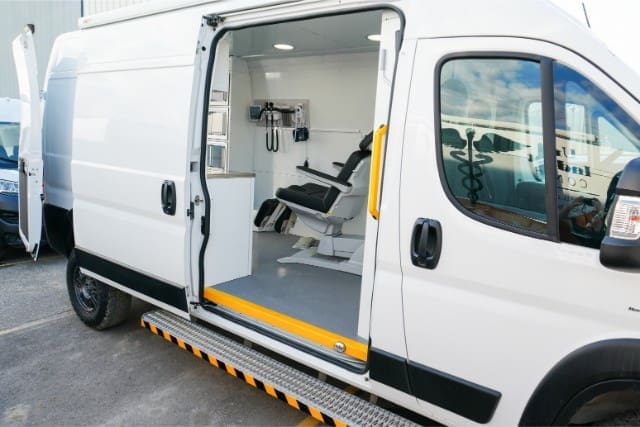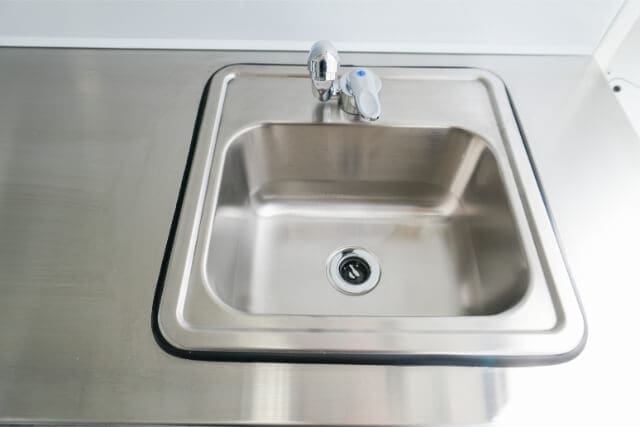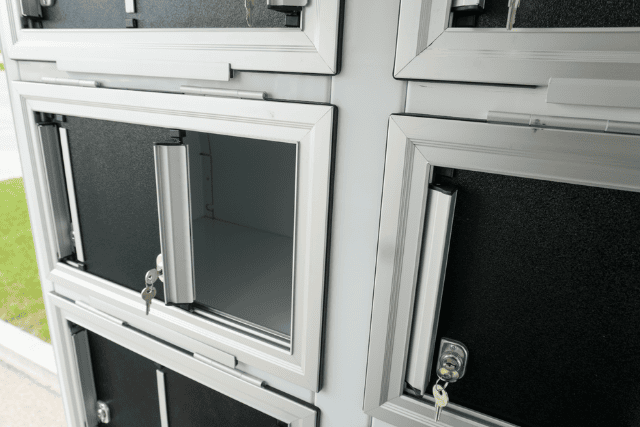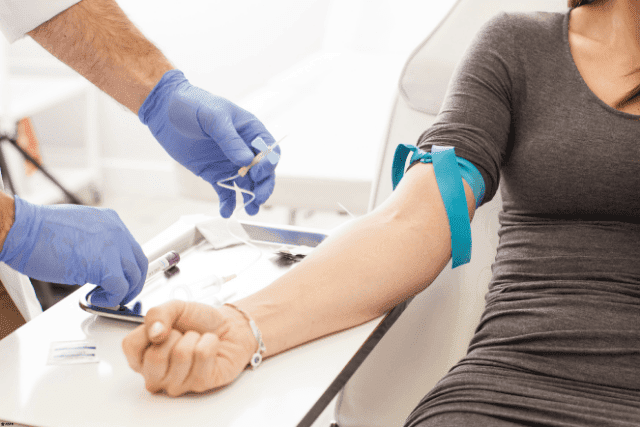The mobile phlebotomy market in the U.S. was worth more than 250 million dollars in 2022, and it’s set to grow past 400 million by 2032. That tells us one thing: blood tests are a big deal, and access to them matters. If you lead a health program, you already know the challenge. People miss blood tests when they can’t get to a lab.
Missed tests lead to late diagnoses, higher costs, and more stress for patients and staff. It feels like you’re trying to close a gap with no bridge. What you want is simple: Bring the lab to the people. Mobile blood testing has the power to do that.
At AVAN Mobility, we’ve been building mobile medical units for more than 10 years. Over 150 units have rolled out nationwide, serving organizations like CalOptima in California and the Community Clinic of Southwest Missouri. Every project starts with listening to your organization’s needs and ends with a clinic that removes barriers to care. While other manufacturers exist, the goal of this article is to answer your questions.
In this article, you’ll learn:
- If blood tests can be done in a mobile medical clinic
- How mobile blood draw services work
- What equipment your mobile medical clinic needs for mobile phlebotomy
Can mobile medical clinics handle blood work and lab tests?
Yes, blood tests can be done in a mobile medical clinic. In fact, mobile medical clinics are one of the most effective ways to bring mobile blood testing to people who might otherwise skip these important tests.
Many patients go without them because they don’t have reliable transportation, there are no blood testing services close to home, or they can’t take time off work. Others may feel uneasy about visiting a hospital or clinic due to past experiences, language barriers, or long wait times. Mobile blood draw services step in to remove those barriers.
Why are blood tests so important?
Blood tests give doctors and nurses a window into someone’s health. They help track chronic diseases like diabetes, check cholesterol levels, or detect infections before they get worse. Without regular testing, patients can end up in the ER when problems could have been managed earlier. That’s costly for hospitals and devastating for families.
For you as an organization, offering mobile phlebotomy through a mobile medical clinic means catching health problems sooner and showing your patients that their health truly matters.
What barriers do mobile medical clinics help overcome for blood testing?
Here are some common reasons people in the U.S. miss blood tests:
- No transportation: Rural towns in states like Montana or Mississippi often lack public transit in some areas, making it tough to reach a lab.
- Long travel times: In remote parts of Alaska, a single trip for blood work can mean hours on the road or even a ferry ride.
- Busy schedules: Single parents working two jobs may not be able to take time off for appointments.
- Limited local options: Small towns across the Midwest may have no nearby blood testing services.
- Health anxiety: Some patients avoid large hospitals but feel safer in a smaller, community-based setting.
Mobile medical clinics flip this script by meeting people where they are.
What does a blood test look like in a mobile medical clinic?

Picture this: A mobile medical unit pulls up outside a community center in rural Arizona. Inside, a nurse greets patients in a space that feels calm and private. The equipment is nearly the same as you’d find in a traditional clinic. A patient sits in a comfortable phlebotomy chair, gets their blood drawn, and is done in minutes. Samples are stored safely and sent to a lab the same day. That simple process saves the patient a long, costly drive and keeps them on track with their care plan.
These mobile blood testing setups aren’t only for rural America. In cities like Los Angeles, mobile medical clinics often park near homeless shelters or schools, bringing phlebotomy services to people who may not step inside a hospital. It’s about making care less intimidating and more accessible.
What’s the impact on communities?
When people can access blood tests more conveniently, they’re more likely to stay on top of their health. That means fewer emergency visits and better long-term outcomes. For organizations, this reduces the strain on staff and shows funders and partners that you’re closing real gaps in healthcare. Patients notice too. They feel valued when your blood testing services come directly to them.
Big takeaway: Mobile blood draw services offered through a mobile medical clinic give your community a fighting chance at better health. They cut through transportation, time, and trust barriers. And they create a stronger bond between you and the people you serve.
What equipment does your mobile medical clinic need for mobile blood test services?
A mobile medical clinic needs the right setup to provide safe and accurate blood tests. The good news is that the equipment is very similar to what you’d find in a regular lab or doctor’s office. Patients may be surprised at how complete these units feel once they step inside.
Essential equipment includes:
- Phlebotomy chair: A comfortable chair with armrests so patients feel steady during their blood draw.

- Sterile supplies: Needles, collection tubes, gloves, alcohol wipes, and bandages are stocked in organized cabinets.
- Refrigeration: Secure, medical-grade refrigerator to store samples until they’re transported to a lab.

- Sharps containers: Safe disposal for used needles and other biohazard materials.
- Handwashing station: Built-in sink with running water to support infection control.

- Storage space: Cabinets and drawers for supplies, so the space stays uncluttered.

Depending on your program, mobile blood testing may also use laptops or tablets for patient records, barcode scanners for labeling, and Wi-Fi for real-time lab communication.
Imagine a mobile medical clinic parked outside a church in rural Texas. Inside, everything patients need for a smooth blood draw is ready. A nurse greets them, they sit in the phlebotomy chair, and in just a few minutes, the blood sample is drawn and safely stored. That patient avoids a 90-minute trip to the nearest hospital, and your team has met a real need right in their community.
When your clinic is set up with the right tools, mobile blood draw services run smoothly. More importantly, patients walk away feeling cared for and confident in their results.
6 challenges to consider before starting mobile blood testing
Starting mobile blood testing in a mobile medical clinic comes with a few things to think through. These aren’t deal-breakers, but they’re good to keep in mind so your program runs smoothly from the start.
1. Licensing and regulations: Each state has its own rules for blood testing and mobile phlebotomy. For example, New York often has stricter lab regulations than other states. It’s important to check with local health departments so your clinic meets all the right standards.
2. Staffing: Mobile medical clinics need trained phlebotomists or nurses who feel comfortable working outside a traditional lab. Some teams choose to rotate staff, while others hire specifically for mobile services. Either way, having the right people in place is key.
3. Funding and sustainability: Securing grants or long-term funding can take planning. Many organizations find success by showing how mobile blood testing lowers emergency visits and improves community health outcomes.
4. Community trust: For many patients, a mobile medical clinic might be their first time getting care outside a hospital. Creating a welcoming, calm space inside the unit helps them feel safe.
5. Outreach and awareness: Patients won’t use mobile blood testing if they don’t know it exists. Community education, flyers, or partnerships with local churches and shelters help spread the word.
6. Scheduling and demand: Figuring out when and where to park the clinic so it reaches the most people can take a little trial and error. Over time, routes and schedules usually become very predictable.
These challenges don’t stop progress. Once solved, your mobile blood draw services can drive real impact, just as organizations across the U.S. have done, building healthier communities and stronger patient relationships.
Ready to bring blood tests to more people with a mobile medical clinic?
You came here wondering if blood tests can really be done in a mobile medical clinic. At the heart of that question is the frustration of missed appointments, long drives, and people in your community going without testing. That gap is real, but it doesn’t have to stay that way.
Here’s what you learned today:
- Blood tests can be done in a mobile medical clinic, and they can reach people who otherwise miss out on it.
- Key equipment, trained staff, and patient trust make mobile blood draw services successful.
- Challenges like funding, regulations, and outreach are manageable when planned for.
We’ve spent more than a decade working alongside health teams, counties, and non-profits across the U.S. At AVAN Mobility, our vehicles are tools that carry trust, dignity, and health into neighborhoods where access has been out of reach. Every mobile unit we build reflects the voices of the people it’s meant to serve. That’s why communities from California to Missouri rely on us to support their programs. If you’re ready to explore how mobile blood testing could fit your mission, click the button below to talk to one of our mobility experts.
If you’re not ready to talk to a mobility expert yet, here are a few resources that can guide you further:
- How do you start a mobile phlebotomy business?: A great next step to understand how to get started.
- Mobile blood draw units vs. traditional phlebotomy labs: Check out this detailed comparison between labs and mobile blood draw units.
- How much does a mobile medical unit cost in the U.S.?: Helps you budget for a clinic that includes blood testing capabilities.




